In times of disaster, whether natural or man-made, plumbing systems play a critical role in maintaining public health, safety, and comfort. These systems are often overlooked in normal circumstances and vital to disaster preparedness efforts. As extreme weather events, earthquakes, floods, and other catastrophes become more frequent and severe, ensuring the resilience and reliability of plumbing infrastructure has become increasingly important. We will explore how plumbing systems in High Point contribute to disaster preparedness, their role in emergency response, and the measures taken to improve plumbing systems to withstand various disasters.
The Role of Plumbing Systems in Disaster Recovery
When disasters strike, the immediate impact on basic utilities like water supply and sanitation can be devastating. Plumbing systems, responsible for providing clean water and removing waste, are essential for preventing the spread of diseases and ensuring a safe living environment. Without functional plumbing, access to drinking water and proper sanitation becomes a major concern, exacerbating the challenges faced by disaster-affected communities. Recovery efforts often rely on repairing or restoring plumbing infrastructure quickly to minimize health risks and restore normalcy. Properly designed plumbing systems can help avoid the contamination of water sources, support medical facilities, and provide a clean water supply for emergency relief efforts. Thus, plumbing systems are not just part of a building’s infrastructure but are integral to maintaining public health and safety during the recovery phase after a disaster.
Plumbing Systems in Flood Zones
Flood-prone areas face unique challenges regarding plumbing systems during natural disasters. Heavy rainfall and rising waters can cause widespread damage to plumbing infrastructure, from burst pipes to flooded sewage systems. In flood zones, plumbing systems must be designed to resist water intrusion and prevent backflow, which could lead to dangerous contamination of drinking water. This means that plumbing systems in such areas often incorporate flood-resistant materials and drainage solutions to mitigate the effects of flooding. Moreover, regular inspections and proactive maintenance are crucial to identifying vulnerabilities and ensuring plumbing systems function properly when a disaster strikes. Communities in flood zones are increasingly adopting disaster-resilient plumbing strategies to minimize the impact of floods, such as elevating plumbing fixtures above expected flood levels and reinforcing pipelines to prevent leaks. As the frequency of flooding increases, these measures become more essential in disaster preparedness plans.
Earthquakes and Plumbing Systems: A Critical Link
In regions prone to earthquakes, plumbing systems’ resilience is paramount. Earthquakes can cause pipes to crack or break, leading to leaks, water shortages, and contamination of water supplies. Plumbing systems must be designed to withstand the forces of seismic activity to ensure the continued flow of water and the effective removal of waste. This requires using flexible materials, such as earthquake-resistant pipes, and employing installation techniques that allow pipes to move slightly without breaking. Additionally, plumbing systems must be integrated into the broader emergency preparedness plans of communities, ensuring that they can be quickly repaired or rerouted in the event of a disaster. For example, water shut-off valves may be strategically placed in key areas to prevent water damage from broken pipes after an earthquake. Regular drills and training on responding to plumbing system failures during an earthquake are critical components of disaster readiness in high-risk seismic zones.
Water Supply and Distribution During a Disaster
One of the most critical functions of plumbing systems during a disaster is distributing clean water. In the aftermath of a natural disaster, access to safe drinking water can be severely limited. Plumbing systems must be equipped to deliver potable water to affected areas, especially to shelters, hospitals, and emergency response centers. Emergency water distribution systems may need to be set up quickly, relying on portable water treatment facilities or temporary plumbing installations. In addition to potable water, the efficient disposal of wastewater becomes a major concern in disaster scenarios. Plumbing systems must be designed for water supply and effectively remove waste, preventing spreading of diseases such as cholera, dysentery, and other waterborne illnesses. In disaster preparedness, communities focus on creating robust water supply chains and ensuring that plumbing infrastructure can withstand the increased demands and stress placed upon it during a crisis.
Preventing Water Contamination and Disease Spread
During and after a disaster, plumbing systems are essential for maintaining sanitary conditions and preventing the spread of diseases. Without functional plumbing, the risk of water contamination increases dramatically, as raw sewage can mix with drinking water supplies. This can lead to infectious diseases such as typhoid fever, hepatitis, and other waterborne illnesses. Properly designed plumbing systems in disaster-prone areas can include features that prevent contamination, such as backflow preventers, air gaps, and filters that clean the water supply. Additionally, emergency sanitation systems, such as portable toilets and temporary waste treatment facilities, are often used in disaster scenarios where plumbing systems may be compromised. By ensuring that plumbing systems are resilient and equipped with the necessary safety measures, communities can significantly reduce the risk of disease transmission in the aftermath of a disaster.
Plumbing systems are indispensable to disaster preparedness, recovery, and response. From providing clean water to preventing the spread of diseases, these systems play a central role in ensuring public health and safety during and after a disaster. As natural disasters become more frequent and severe, the resilience of plumbing infrastructure must be prioritized. Whether through improved design, innovative technologies, or proactive planning, ensuring that plumbing systems can withstand the challenges posed by floods, earthquakes, and other catastrophes is crucial. By strengthening plumbing systems and integrating them into broader disaster preparedness strategies, communities can better protect their populations and recover more swiftly from the impact of disasters.
